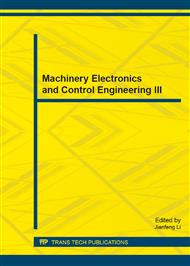[1]
B. Rankov, A. Wittneben: Spectral efficient protocols for half-duplex fading relay channels. IEEE J. Select. Areas commun. Vol. 25(2007), pp.379-389.
DOI: 10.1109/jsac.2007.070213
Google Scholar
[2]
I. Hammerstroem, M. kuhn, C. Esli, J. Zhao, A. Wittneben, and G. Bauch: MIMO two-way relaying with transmit CSI at the relay. IEEE Int. Workshop on Signal Process, Advances for Wireless Comm. (2007). pp.17-20.
DOI: 10.1109/spawc.2007.4401421
Google Scholar
[3]
T. J. Oechtering, C, Schnurr, I. Bjelakovic, and H. Boche: Broadcast Capacity Region of Two-phase Bidirectional relaying. IEEE Trans. Inform. Theory, Vol. 54(2008), pp.454-458.
DOI: 10.1109/tit.2007.911158
Google Scholar
[4]
S. Zhang, S. Liew, and P. Lam: Hot topic: Physical layer network coding. Proceedings of the 12th Annual International Conference on Mobile Computing and Networking. (2006), pp.358-365.
DOI: 10.1145/1161089.1161129
Google Scholar
[5]
R. Ahlswede, N. Cai, S. -Y.R. Li, and R.W. -H. Yeung: Network information flow. IEEE Trans. Inf. Theory. vol. 46(2000), pp.1204-1216.
DOI: 10.1109/18.850663
Google Scholar
[6]
E. Fasolo, F. Rossetto, and M. Zorzi: Network coding meets MIMO. Network Coding, Theory and Applications, Fourth Workshop on NetCod 2008, pp.1-6.
DOI: 10.1109/netcod.2008.4476169
Google Scholar
[7]
M. Kiessling and J. Special: Analytical performance of MIMO zero-forcing receivers in correlated Raleigh fading environments. Signal Processing Advances in Wireless Communications2003, pp.383-387.
DOI: 10.1109/spawc.2003.1318987
Google Scholar
[8]
M. Kiessling, and J. Special: Analytical performance of MIMO MMSE receivers in correlated Raleigh fading environment. Vehicular Technology Conference 2003, pp.1738-1742.
DOI: 10.1109/vetecf.2003.1285323
Google Scholar
[9]
S.M. Alamouti: A simple transmit diversity technique for wireless communication. IEEE J. Sel. Areas Commun, Vol. 16(1998), No. 2, pp.1451-1458.
DOI: 10.1109/49.730453
Google Scholar


